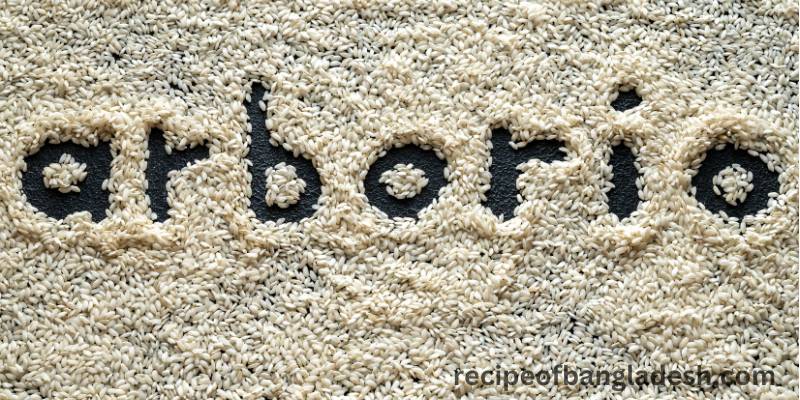Arborio rice is a type of short-grain rice that is commonly used in Italian cuisine, particularly in dishes like risotto. Unlike regular rice, arborio rice has a higher starch content and a slightly different texture, making it suitable for dishes that require a creamy consistency.
However, this does not mean that arborio rice cannot be cooked like regular rice. In fact, the process of cooking arborio rice is similar to cooking regular rice. Both types of rice can be rinsed and then boiled in a pot with a measured amount of water until the water has been absorbed.
The main differences between cooking arborio rice and regular rice are the cooking time and the amount of liquid needed. Arborio rice may take longer to cook than regular rice, due to its higher starch content, and it may also require more liquid to achieve the desired creamy texture.
Additionally, the final dish should also be taken into consideration when cooking arborio rice. Some dishes, like risotto, require a creamy texture, while others may call for firmer rice.
Here, I share some tips on how to adjust the cooking time and liquid amount as needed to achieve the best results.
Keep in mind that the texture of the cooked rice is a key consideration when cooking arborio rice, and that the desired texture of the final dish should also be taken into account.
With these considerations in mind, it is possible to cook arborio rice like regular rice, and to achieve delicious and satisfying results.

Can I Cook Arborio Rice Like Regular Rice?
Yes, Arborio rice can be cooked like regular rice. To do so, you can use the standard ratio of 2 cups of water to 1 cup of arborio rice.
It is important to note that arborio rice is a very starchy variety, so you may want to rinse it before cooking to reduce the amount of starch released during the cooking process.
When cooking Arborio rice like regular rice, it is important to rinse the rice beforehand to remove some of the excess starch. Additionally, you may want to use a slightly larger amount of water compared to regular rice, as Arborio rice has a tendency to absorb more liquid.
In terms of cooking time, Arborio rice will take slightly longer to cook than regular white rice. On average, Arborio rice will take about 18-20 minutes to cook, while regular white rice will take about 15-18 minutes.
By following my techniques and recipes, you can successfully cook delicious arborio rice dishes.
Explore More Information: Check Out the FAQs at the End of the Article.
How to Cook Arborio Rice like Regular Rice?
Rinsing the Rice
Before cooking, rinse the arborio rice in a fine mesh strainer to remove any dirt or debris. This step is optional, but can help reduce the amount of starch released during cooking.
Measuring the Water
Measure out 2 cups of water for every 1 cup of arborio rice.
Boiling the Rice
Bring the water to a boil in a large saucepan. Once the water is boiling, add the rinsed arborio rice, stir gently, and reduce the heat to low. Cover the saucepan and simmer until all the water has been absorbed and the rice is tender, approximately 18-20 minutes.
Do not lift the lid or stir the rice during cooking, as this can release steam and affect the final texture. When the rice is fully cooked, remove the saucepan from heat and let it sit, covered, for a few minutes before serving.
Keep in Mind When Cooking Arborio Rice
Cooking Time
The cooking time for arborio rice can vary slightly due to differences in stovetop temperature, saucepan size, and other factors. In general, it takes approximately 18-20 minutes to fully cook arborio rice.
Amount of Liquid Needed
The 2:1 ratio of water to arborio rice is a general guideline, and the actual amount of water needed can vary based on the desired texture of the final dish. If you prefer a creamier texture, you may want to add a little more water. Conversely, if you prefer a firmer texture, you may want to use a little less water.
Desired Texture of Final Dish
The high starch content of arborio rice makes it a good choice for dishes that require a creamy texture, such as risotto. However, the desired texture can also depend on personal preference and the recipe you are using.
When cooking arborio rice like regular rice, it is important to keep in mind the desired texture of the final dish and make any necessary adjustments to the cooking time and amount of liquid used.
In conclusion, while Arborio rice can be cooked like regular rice, it is important to take into consideration the differences in texture, absorption, and cooking time to achieve the best results.
Enjoy your creamy and delicious arborio rice!
Some FAQs About Arborio Rice
Is Arborio Rice Better Than White Rice?
Arborio rice and white rice are both popular grains, but they have different characteristics and are used in different dishes.
Arborio rice is a type of short-grain rice that is high in starch content and is commonly used in dishes such as risotto, where a creamy texture is desired. White rice is a long-grain rice that has a mild flavor and a drier, fluffier texture.
Whether arborio rice is better than white rice depends on personal preference and the dish you are preparing.
If you are making a dish that requires a creamy texture, such as risotto, then arborio rice would be the better choice. If you are making a dish that requires a drier texture, such as stir-fry, then white rice would be the better choice.
Ultimately, both arborio rice and white rice have their own unique qualities and can be used in a variety of dishes. It is a matter of choosing the right grain for your desired outcome.
Is Arborio Rice a Glutinous Rice?
No, arborio rice is not a glutinous rice. Arborio rice is a type of short-grain rice that is high in starch content and is commonly used in Italian dishes, such as risotto. It is not gluey or sticky when cooked, but rather has a creamy texture.
Glutinous rice, also known as sticky rice, is a type of short-grain rice that is gluey and sticky when cooked.
It is often used in Asian dishes, such as sushi and rice pudding. Glutinous rice is different from arborio rice in that it has a much stickier texture due to its higher starch content and lower protein content.
While arborio rice and glutinous rice are both short-grain rices, they are different in terms of their texture and are used in different types of dishes.
Can You Use Arborio Rice to Make Fried Rice?
Yes, you can use arborio rice to make fried rice. However, due to its high starch content, arborio rice may not hold up as well as long-grain rice when stir-frying.
The high starch content can cause the rice to become sticky and clump together, rather than staying separate and fluffy.
If you do use arborio rice for fried rice, it is best to use leftover, chilled rice that has been previously cooked and allowed to cool in the refrigerator.
This will help the grains stay separate during the stir-frying process. Additionally, you may need to use a bit more oil or a non-stick pan to prevent the rice from sticking together.
It’s worth noting that while arborio rice can be used for fried rice, it may not produce the traditional texture and appearance that you expect from fried rice.
If you’re looking for the classic texture and flavor of fried rice, it is best to use long-grain rice, such as jasmine or basmati rice.
How Long Do I Boil Arborio Rice?
The cooking time for arborio rice can vary depending on several factors, including the altitude, the amount of rice you are cooking, and your desired texture. However, as a general guideline, it typically takes between 18 to 20 minutes to boil arborio rice.
Here’s a simple method for boiling arborio rice:
Rinse 1 cup of arborio rice in a fine mesh strainer under cold running water.
Place the rinsed rice in a saucepan and add 2 cups of water.
Bring the water to a boil over high heat.
Reduce the heat to low, cover the saucepan with a tight-fitting lid, and simmer for 18 to 20 minutes, or until the water has been absorbed and the rice is tender.
Remove the saucepan from heat and let it stand for a few minutes to allow the rice to finish steaming.
Fluff the rice with a fork and serve.
It is worth noting that arborio rice is often used in dishes like risotto, where it is cooked with liquids other than water and the cooking time can be longer.
In these dishes, the rice is gradually cooked in broth or wine, absorbing the liquids and creating a creamy texture.
Do You Wash Arborio Rice Before Using?
Yes, it is recommended to wash Arborio rice before using it. This helps to remove any dirt, dust, or starch that may be present on the surface of the rice. Rinsing the rice can also prevent the grains from sticking together, resulting in a fluffier texture.
To wash Arborio rice, simply place it in a fine mesh strainer and rinse it under running water until the water runs clear.
This process takes only a few minutes, and it can make a significant difference in the quality of your final dish. After rinsing, drain the rice thoroughly before using it in your recipe.
Can You Overcook Arborio Rice?
Yes, you can overcook Arborio rice. Overcooking can cause the rice to become mushy, sticky, and break apart, leading to a final dish that is less appealing in texture and flavor.
Arborio rice is a type of short-grain rice that is used to make dishes such as risotto. When cooked correctly, it should be tender and slightly firm, with a creamy and smooth texture. To avoid overcooking, it is important to follow a recipe and pay close attention to the cooking time, as well as the amount of liquid you add to the rice.
If you find that you have overcooked your Arborio rice, there is not much you can do to rescue it.
However, you can still use it in recipes where the texture is not as important, such as soup or stews, or as a base for a stir-fry dish.
Additionally, you can use leftover overcooked Arborio rice as an ingredient in other recipes, such as rice pudding or fried rice.
Does Arborio Rice Double When Cooked?
Arborio rice will expand in volume when cooked, but it will not double in size. On average, Arborio rice will expand to about 2 to 2.5 times its original volume. This expansion occurs as the rice absorbs the liquid it is cooked in and the starch in the rice swells, causing the grains to become larger and plumper.
It is important to note that the exact amount of expansion will depend on the amount of liquid used, the cooking method, and the specific type of Arborio rice. However, as a general rule, you can expect Arborio rice to expand to about 2 to 2.5 times its original volume when cooked.

Leave a Reply